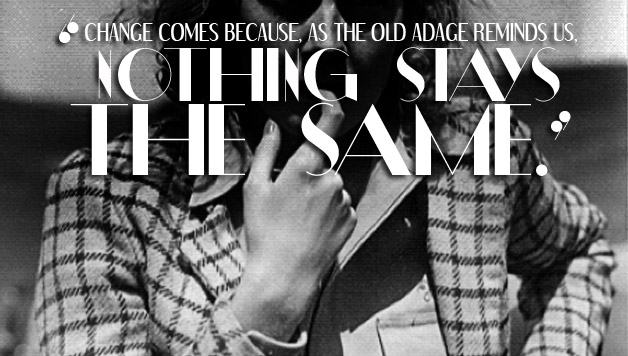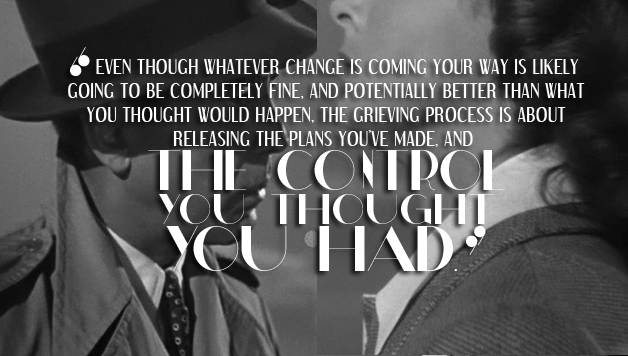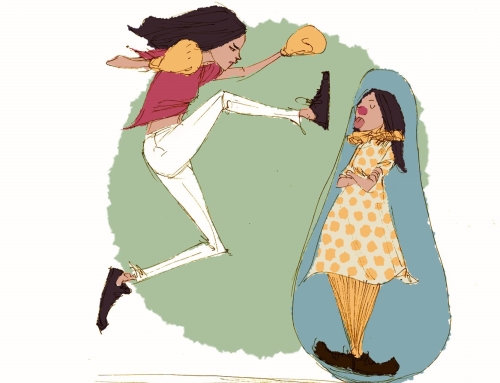I have always been terrified of change.
I was a shy little bookworm who lived in her imagination, and the best way to have that world flourish, always seemed to be for the real world going on around me to be as placid and sedate as possible. My parents knew that to ensure I adjusted to change without some ridiculous meltdown, they needed to give me a lot of advance lead time to think about any upcoming shifts in my narrow little world.
I was often sat down to hear about the fact that one of them would be out of town three weekends from now, or that the living room couch was going to be recovered at some point in the next few months. Yes, as you may have already grasped, I am occasionally (often) neurotic and a world-class fraidey-cat about many, many things. And the point of this tale of my childhood freakishness? Change is scary (duh) for everyone, and especially for some like me. That said, it is also the very best thing at times, like it or not.
There are infinite ways to ruin relationships: friendships, romances, et al. From my vantage point though, I can honestly say the number one way to torch something is to be too afraid to change it when change is needed. Fear makes people mute. The words that need to be said sit heavy in the pit of your stomach and hang in the roof of your mouth like sleeping bats. Rather than shake the foundation by telling someone how you feel — I love you, I need more, I can’t go on like this — you sit and let the fear morph from a vapour to a solid obstructive substance between you. As it hardens, change becomes less and less possible. Fear of change is bad for all areas of life, and I could go into a whole rant about how dangerous it is for a career, but at the top of the list of ways it can squelch your spirit is in our most important relationships.

There are certain moments in our lives that feel gloriously perfect. We meet someone, or even a group of people (friends not lovers you gutter-brains) and are suddenly happy — deeply happy in a way that reaches into us and fills every seam. These are the moments we all are striving for; they are what we are looking for each time we begin a new relationship, and the promise we feel when we make a new and amazing friend. “This is it,” we think, “now I’m happy.” And we stay in these moments as long as we can, like a cat curled up in the sun. We aren’t afraid because this new feeling, and the people and sequence of events that have made it possible, seem so much larger and more immovable than anything else — there’s no way it could change. And then, of course, it does.
Change comes because, as the old adage reminds us, nothing stays the same. The trick of embracing change is that the outcome always lies with how you respond to the way the sand shifts under your feet. Try and ignore it, and you will quickly be in the uncomfortable position of living in a fiction. The more you try and convince yourself that if you white-knuckle it for long enough things will just stay the same, the more it starts to just feel like lying. And since lying to yourself is the worst kind of lying you can do in my opinion, it is best to put on your big girl/boy pants and face change when you need to. Here’s how:
Step 1: Take a deep breath.
As a grade A, world-class panicker, I completely understand the impulse to swing into meltdown mode when the lovely picture in your head of how things would be suddenly gets trashed by someone else’s choices (or just life being a bitch). Panic is what gets you trampled in a nightclub fire, or lands you in in a ditch on a slippery highway. The only thing to do when you feel like bolting all over the place like a damn rabbit is to stay very still, take deep breaths and do nothing.
It seems like the opposite of what I have been saying, right? Embracing change is all about action. Truth. But you need to have a clear head and a semi-reasonable plan of what direction you will choose before you start reacting. So take a deep breath or two. For a day or a week or two. Part of taking advantage of change is that you choose how you will react to it, so give yourself time to do that.
Step 2: Grieve the ways you thought things were going to be.
It is important to do this after you’ve collected your thoughts and have a bit of a plan in place. Otherwise this process could spin out into a Fear and Loathing in Las Vegas-style spiral, which while fun in theory, is almost always ill advised. However, once you have made a decision of what change will look like in the circumstance you are in, it is more than fair to indulge in a small and inelegant pity party.
Even though whatever change is coming your way is likely going to be completely fine, and potentially better than what you thought would happen, the grieving process is about releasing the plans you had made, and the control you thought you had. It is frustrating, especially for us worrywarts, list makers and control freaks, to have to shift gears away from the way we think things should be, so by all means take some time to wallow and rail at the universe.

Step 3: Take it on the chin and keep it moving.
You’ve taken it in, and released the ghosts of what you thought would be. Now is the hardest part. Change feels best when we embrace it wholeheartedly, so once you have prepared yourself, take action.
Often this action is in the form of words. Whatever it is that needs to change — a friendship that has shifted from perfect to poisonous, a partnership that has lost its equilibrium — the only way to fix it is to tell the other person why it isn’t working for you. Since you have taken your time, and made your peace with the fact that going backwards to the perfect picture you hoped for isn’t possible, you can now be the one to decide what change is needed and communicate that to whoever it is that needs to get told.
The scary part about this is that other people rarely do exactly what we think they will. The fact that you are calling the shots may make them feel defensive, and that doesn’t bring out the best in anyone. Prepare yourself.
That said, whatever happens when you finally take the steps forward that are needed will likely be far less bad than all the scenarios that you’ve been plaguing yourself by imagining. Grin and bear it, stick to the plans you have made and the new goals you have set, and before you know it you will be through it, and life will likely look and feel better than expected.
The truth is nothing is exactly what we think it will be, and life is made up of the crooked, awkward and half-baked reality, stitched together by the golden thread of those perfect happy moments. It is far better to suffer the discomfort of change for the relatively short time period it takes to go through it, than live in fear of it and compromise yourself in the process.
So clear your throat, square your shoulders and say the things that need to be said. I will see you on the other side; it’s better over here.
Published June 28, 2013











